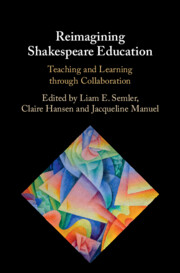Book contents
- Reimagining Shakespeare Education
- Reimagining Shakespeare Education
- Copyright page
- Dedication
- Contents
- Figures
- Tables
- Notes on Contributors
- Acknowledgements
- Introduction
- Part I Reimagining Shakespeare with/in Schools
- Part II Reimagining Shakespeare with/in Universities
- Part III Public Reimaginings
- Introduction
- Chapter 9 Hecate
- Chapter 10 ‘I’ll Teach you Differences’
- Chapter 11 The Pop-up Globe
- Chapter 12 The Place of Shakespeare North
- Part IV Digital Reimaginings
- Part V Reimagining Performance
- Afterword
- Index
- References
Chapter 9 - Hecate
Adaptation, Education and Cultural Activism
from Part III - Public Reimaginings
Published online by Cambridge University Press: 02 February 2023
- Reimagining Shakespeare Education
- Reimagining Shakespeare Education
- Copyright page
- Dedication
- Contents
- Figures
- Tables
- Notes on Contributors
- Acknowledgements
- Introduction
- Part I Reimagining Shakespeare with/in Schools
- Part II Reimagining Shakespeare with/in Universities
- Part III Public Reimaginings
- Introduction
- Chapter 9 Hecate
- Chapter 10 ‘I’ll Teach you Differences’
- Chapter 11 The Pop-up Globe
- Chapter 12 The Place of Shakespeare North
- Part IV Digital Reimaginings
- Part V Reimagining Performance
- Afterword
- Index
- References
Summary
Premiering at Perth Festival in 2020, Hecate is the first stage adaptation of Shakespearean work, in this case Macbeth, to be performed entirely in one Aboriginal language from Australia, specifically the Noongar language from Western Australia’s southwest. Australia is home to hundreds of Aboriginal languages, most of which are endangered due to settler-colonial suppression of Aboriginal culture. Today, although there are over 30,000 Noongar people, the Noongar language is rarely heard spoken in full sentences. More than being a significant artistic achievement, presenting Shakespeare in Noongar has provided a rare opportunity for Noongar and other people to actively engage with the Noongar language in deep and lasting ways. As a nation with a noted cultural cringe, Australia places high cultural value on Shakespeare. The opportunity to develop Hecate as a Noongar-language work arose because engaging with the English literary tradition – and particularly Shakespeare – attracted the necessary government and philanthropic support, media attention and audience interest. In Hecate, Shakespeare’s venerated status has been subversively used as a chink in the settler-colonial armour through which Noongar cultural activism, and deeper ‘felt’ intercultural understanding has been achieved via various collaborative processes, most importantly in developing a Noongar language-speaking ensemble of Noongar actors.
- Type
- Chapter
- Information
- Reimagining Shakespeare EducationTeaching and Learning through Collaboration, pp. 145 - 158Publisher: Cambridge University PressPrint publication year: 2023

